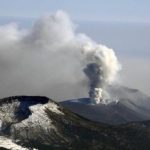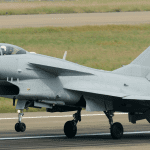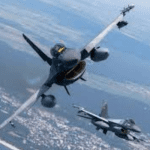Japan’s cabinet has approved the export of new fighter jets it is developing with the UK and Italy, in the latest move away from its pacifist policies.
It eased arms export rules to allow the jets to be sold to countries that Japan has signed defence pacts with, and where there is no ongoing conflict.
Japan has pledged to double military spending by 2027, citing threats posed by China and North Korea.
Each fighter jet sale will require cabinet approval, authorities said.
In December 2022, Japan joined a UK-Italy collaboration, dubbed the Tempest, to develop this new fighter jet that will use artificial intelligence and advanced sensors to assist pilots.
The jets are expected to be deployed by 2035 – in what is Tokyo’s first defence equipment development partnership with a country other than the US.
The latest move comes ahead of Prime Minister Fumio Kishida’s official visit to the US in April, where he is expected to stress Tokyo’s alliance with Washington and his country’s readiness to be more involved in defence partnerships.
Mr Kishida had also said that allowing the export of warplanes to third countries is “necessary” to maintain Tokyo’s credibility as a partner in other future international defence projects.
After World War Two, the US-occupied Japan adopted a constitution which says the country renounces war and the use of force to settle international disputes. The constitution does not officially recognise the military and limits it to self-defence capabilities.
It also imposed an arms export ban, which was eased for the first time in 2014 under then-Prime Minister Shinzo Abe.
In December 2023, Japan eased the rules further to allow the sale of lethal weapons it makes under foreign licenses to be exported to the country where the licenser is based.
This paved the way for Tokyo to send Patriot air defence missiles to the US. Patriot missiles are among the most advanced weapons supplied by the US to Ukraine.
Japan’s cabinet has approved the export of new fighter jets it is developing with the UK and Italy, in the latest move away from its pacifist policies.
It eased arms export rules to allow the jets to be sold to countries that Japan has signed defence pacts with, and where there is no ongoing conflict.
Japan has pledged to double military spending by 2027, citing threats posed by China and North Korea.
Each fighter jet sale will require cabinet approval, authorities said.
In December 2022, Japan joined a UK-Italy collaboration, dubbed the Tempest, to develop this new fighter jet that will use artificial intelligence and advanced sensors to assist pilots.
The jets are expected to be deployed by 2035 – in what is Tokyo’s first defence equipment development partnership with a country other than the US.
The latest move comes ahead of Prime Minister Fumio Kishida’s official visit to the US in April, where he is expected to stress Tokyo’s alliance with Washington and his country’s readiness to be more involved in defence partnerships.
Mr Kishida had also said that allowing the export of warplanes to third countries is “necessary” to maintain Tokyo’s credibility as a partner in other future international defence projects.
After World War Two, the US-occupied Japan adopted a constitution which says the country renounces war and the use of force to settle international disputes. The constitution does not officially recognise the military and limits it to self-defence capabilities.
It also imposed an arms export ban, which was eased for the first time in 2014 under then-Prime Minister Shinzo Abe.
In December 2023, Japan eased the rules further to allow the sale of lethal weapons it makes under foreign licenses to be exported to the country where the licenser is based.
This paved the way for Tokyo to send Patriot air defence missiles to the US. Patriot missiles are among the most advanced weapons supplied by the US to Ukraine.
Japan’s cabinet has approved the export of new fighter jets it is developing with the UK and Italy, in the latest move away from its pacifist policies.
It eased arms export rules to allow the jets to be sold to countries that Japan has signed defence pacts with, and where there is no ongoing conflict.
Japan has pledged to double military spending by 2027, citing threats posed by China and North Korea.
Each fighter jet sale will require cabinet approval, authorities said.
In December 2022, Japan joined a UK-Italy collaboration, dubbed the Tempest, to develop this new fighter jet that will use artificial intelligence and advanced sensors to assist pilots.
The jets are expected to be deployed by 2035 – in what is Tokyo’s first defence equipment development partnership with a country other than the US.
The latest move comes ahead of Prime Minister Fumio Kishida’s official visit to the US in April, where he is expected to stress Tokyo’s alliance with Washington and his country’s readiness to be more involved in defence partnerships.
Mr Kishida had also said that allowing the export of warplanes to third countries is “necessary” to maintain Tokyo’s credibility as a partner in other future international defence projects.
After World War Two, the US-occupied Japan adopted a constitution which says the country renounces war and the use of force to settle international disputes. The constitution does not officially recognise the military and limits it to self-defence capabilities.
It also imposed an arms export ban, which was eased for the first time in 2014 under then-Prime Minister Shinzo Abe.
In December 2023, Japan eased the rules further to allow the sale of lethal weapons it makes under foreign licenses to be exported to the country where the licenser is based.
This paved the way for Tokyo to send Patriot air defence missiles to the US. Patriot missiles are among the most advanced weapons supplied by the US to Ukraine.
Japan’s cabinet has approved the export of new fighter jets it is developing with the UK and Italy, in the latest move away from its pacifist policies.
It eased arms export rules to allow the jets to be sold to countries that Japan has signed defence pacts with, and where there is no ongoing conflict.
Japan has pledged to double military spending by 2027, citing threats posed by China and North Korea.
Each fighter jet sale will require cabinet approval, authorities said.
In December 2022, Japan joined a UK-Italy collaboration, dubbed the Tempest, to develop this new fighter jet that will use artificial intelligence and advanced sensors to assist pilots.
The jets are expected to be deployed by 2035 – in what is Tokyo’s first defence equipment development partnership with a country other than the US.
The latest move comes ahead of Prime Minister Fumio Kishida’s official visit to the US in April, where he is expected to stress Tokyo’s alliance with Washington and his country’s readiness to be more involved in defence partnerships.
Mr Kishida had also said that allowing the export of warplanes to third countries is “necessary” to maintain Tokyo’s credibility as a partner in other future international defence projects.
After World War Two, the US-occupied Japan adopted a constitution which says the country renounces war and the use of force to settle international disputes. The constitution does not officially recognise the military and limits it to self-defence capabilities.
It also imposed an arms export ban, which was eased for the first time in 2014 under then-Prime Minister Shinzo Abe.
In December 2023, Japan eased the rules further to allow the sale of lethal weapons it makes under foreign licenses to be exported to the country where the licenser is based.
This paved the way for Tokyo to send Patriot air defence missiles to the US. Patriot missiles are among the most advanced weapons supplied by the US to Ukraine.
Japan’s cabinet has approved the export of new fighter jets it is developing with the UK and Italy, in the latest move away from its pacifist policies.
It eased arms export rules to allow the jets to be sold to countries that Japan has signed defence pacts with, and where there is no ongoing conflict.
Japan has pledged to double military spending by 2027, citing threats posed by China and North Korea.
Each fighter jet sale will require cabinet approval, authorities said.
In December 2022, Japan joined a UK-Italy collaboration, dubbed the Tempest, to develop this new fighter jet that will use artificial intelligence and advanced sensors to assist pilots.
The jets are expected to be deployed by 2035 – in what is Tokyo’s first defence equipment development partnership with a country other than the US.
The latest move comes ahead of Prime Minister Fumio Kishida’s official visit to the US in April, where he is expected to stress Tokyo’s alliance with Washington and his country’s readiness to be more involved in defence partnerships.
Mr Kishida had also said that allowing the export of warplanes to third countries is “necessary” to maintain Tokyo’s credibility as a partner in other future international defence projects.
After World War Two, the US-occupied Japan adopted a constitution which says the country renounces war and the use of force to settle international disputes. The constitution does not officially recognise the military and limits it to self-defence capabilities.
It also imposed an arms export ban, which was eased for the first time in 2014 under then-Prime Minister Shinzo Abe.
In December 2023, Japan eased the rules further to allow the sale of lethal weapons it makes under foreign licenses to be exported to the country where the licenser is based.
This paved the way for Tokyo to send Patriot air defence missiles to the US. Patriot missiles are among the most advanced weapons supplied by the US to Ukraine.
Japan’s cabinet has approved the export of new fighter jets it is developing with the UK and Italy, in the latest move away from its pacifist policies.
It eased arms export rules to allow the jets to be sold to countries that Japan has signed defence pacts with, and where there is no ongoing conflict.
Japan has pledged to double military spending by 2027, citing threats posed by China and North Korea.
Each fighter jet sale will require cabinet approval, authorities said.
In December 2022, Japan joined a UK-Italy collaboration, dubbed the Tempest, to develop this new fighter jet that will use artificial intelligence and advanced sensors to assist pilots.
The jets are expected to be deployed by 2035 – in what is Tokyo’s first defence equipment development partnership with a country other than the US.
The latest move comes ahead of Prime Minister Fumio Kishida’s official visit to the US in April, where he is expected to stress Tokyo’s alliance with Washington and his country’s readiness to be more involved in defence partnerships.
Mr Kishida had also said that allowing the export of warplanes to third countries is “necessary” to maintain Tokyo’s credibility as a partner in other future international defence projects.
After World War Two, the US-occupied Japan adopted a constitution which says the country renounces war and the use of force to settle international disputes. The constitution does not officially recognise the military and limits it to self-defence capabilities.
It also imposed an arms export ban, which was eased for the first time in 2014 under then-Prime Minister Shinzo Abe.
In December 2023, Japan eased the rules further to allow the sale of lethal weapons it makes under foreign licenses to be exported to the country where the licenser is based.
This paved the way for Tokyo to send Patriot air defence missiles to the US. Patriot missiles are among the most advanced weapons supplied by the US to Ukraine.
Japan’s cabinet has approved the export of new fighter jets it is developing with the UK and Italy, in the latest move away from its pacifist policies.
It eased arms export rules to allow the jets to be sold to countries that Japan has signed defence pacts with, and where there is no ongoing conflict.
Japan has pledged to double military spending by 2027, citing threats posed by China and North Korea.
Each fighter jet sale will require cabinet approval, authorities said.
In December 2022, Japan joined a UK-Italy collaboration, dubbed the Tempest, to develop this new fighter jet that will use artificial intelligence and advanced sensors to assist pilots.
The jets are expected to be deployed by 2035 – in what is Tokyo’s first defence equipment development partnership with a country other than the US.
The latest move comes ahead of Prime Minister Fumio Kishida’s official visit to the US in April, where he is expected to stress Tokyo’s alliance with Washington and his country’s readiness to be more involved in defence partnerships.
Mr Kishida had also said that allowing the export of warplanes to third countries is “necessary” to maintain Tokyo’s credibility as a partner in other future international defence projects.
After World War Two, the US-occupied Japan adopted a constitution which says the country renounces war and the use of force to settle international disputes. The constitution does not officially recognise the military and limits it to self-defence capabilities.
It also imposed an arms export ban, which was eased for the first time in 2014 under then-Prime Minister Shinzo Abe.
In December 2023, Japan eased the rules further to allow the sale of lethal weapons it makes under foreign licenses to be exported to the country where the licenser is based.
This paved the way for Tokyo to send Patriot air defence missiles to the US. Patriot missiles are among the most advanced weapons supplied by the US to Ukraine.
Japan’s cabinet has approved the export of new fighter jets it is developing with the UK and Italy, in the latest move away from its pacifist policies.
It eased arms export rules to allow the jets to be sold to countries that Japan has signed defence pacts with, and where there is no ongoing conflict.
Japan has pledged to double military spending by 2027, citing threats posed by China and North Korea.
Each fighter jet sale will require cabinet approval, authorities said.
In December 2022, Japan joined a UK-Italy collaboration, dubbed the Tempest, to develop this new fighter jet that will use artificial intelligence and advanced sensors to assist pilots.
The jets are expected to be deployed by 2035 – in what is Tokyo’s first defence equipment development partnership with a country other than the US.
The latest move comes ahead of Prime Minister Fumio Kishida’s official visit to the US in April, where he is expected to stress Tokyo’s alliance with Washington and his country’s readiness to be more involved in defence partnerships.
Mr Kishida had also said that allowing the export of warplanes to third countries is “necessary” to maintain Tokyo’s credibility as a partner in other future international defence projects.
After World War Two, the US-occupied Japan adopted a constitution which says the country renounces war and the use of force to settle international disputes. The constitution does not officially recognise the military and limits it to self-defence capabilities.
It also imposed an arms export ban, which was eased for the first time in 2014 under then-Prime Minister Shinzo Abe.
In December 2023, Japan eased the rules further to allow the sale of lethal weapons it makes under foreign licenses to be exported to the country where the licenser is based.
This paved the way for Tokyo to send Patriot air defence missiles to the US. Patriot missiles are among the most advanced weapons supplied by the US to Ukraine.














